Make install/deploy index names unique. Implemented patcheset 1 review comment. Signed-off-by: Ron Stone <ronald.stone@windriver.com> Change-Id: Idec2a9f701242f33c0e84048e109c49a5adee3ad
17 KiB
Time Sensitive Networking
This guide describes how to deploy and run Time Sensitive Networking (TSN) applications on StarlingX virtual machines.
Introduction
Embedded sectors such as automotive, industrial, professional audio/video networking, as well as blockchain and high frequency trading have emphasized the need for real-time networks. Common LAN models are based on Internet protocols and the IEEE 802 architecture, where operations are best-effort which is not suitable for edge computing use cases that require high/known/deterministic availability.
Time Sensitive Networking (TSN) is a set of evolving standards developed by the IEEE 802.1 Working Group to cover a group of vendor-neutral and IEEE standards with the aim of guaranteeing determinism in delivering time-sensitive traffic with low and bounded latency within an infinitesimal packet loss over the network, while allowing non time-sensitive traffic to be carried through the same network. It is also a key technology that targets the previously listed edge computing segments.
StarlingX (STX) is a complete cloud infrastructure software stack for the edge that provides running workloads on both virtual machine and container environments.
This guide shows how to deploy and run a TSN application on a STX virtual machine. It includes TSN reference applications which are taken from TSN Reference Software for Linux with a focus on 2 key use cases:
IEEE 802.1Qav or Credit Based Shaper (CBS)
Ensure bounded transmission latency for time sensitive, loss-sensitive, real-time data stream in some critical user scenarios. For instance, when time sensitive traffic and best-effort traffic are transmitted together, users require the bandwidth and latency of time-sensitive traffic is protected in the midst of overloaded traffic on the same network, that is, ensure that the time-sensitive traffic has a constant transmission rate and latency.
IEEE 802.1Qbv or Time Aware Shaper (TAS)
Create a protected transmission window for scheduled traffic, which requires low and bounded transmission latency. Scheduled traffic is the term used in IEEE 802.1Qbv to refer to periodic traffic such as industrial automation control frames. This type of traffic is short in frame length and requires immediate transmission when its schedule starts.
Requirements
The TSN reference application has been verified on the following environments:
| Hardware |
|
| Software |
|
Demo environment setup
The following diagram shows the setup for the demo:
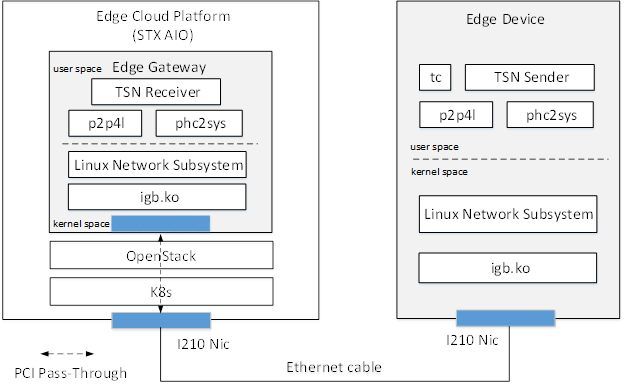
The demo uses the hardware and software components listed below:
- Edge cloud platform: built based on STX All-In-One (AIO) which provides IaaS infrastructure for edge cloud environment.
- Edge device: edge side device to generate TSN data for processing.
- Intel® Ethernet Controller I210: installed on both
the edge cloud platform node and edge device and connected by CAT-5E
Ethernet cable.
Igb.kois the corresponding Linux kernel driver which has been included in Linux. - Edge gateway: a virtual machine created by STX. Acts as gateway to collect TSN data, perform edge computing, and send to data center. The I210 adapter is exposed to the edge gateway from the host node through OpenStack Nova's PCI pass-through support.
- p2p4l and phc2sys: utilities from the LinuxPTP project to support time synchronization over PTP.
- tc: utility/command used to configure Traffic Control in the Linux kernel.
- TSN Sender/Receiver: TSN reference application from TSN Reference Software for Linux to send/receive TSN data for processing.
Deploy TSN applications on STX
Edge cloud platform
Install STX environment: follow the instructions from the
Installation Guides <index-install-e083ca818006>to install one STX environment (for example STX AIO).Prepare a
VM (Virtual Machine)image. Create imagetsn_ubuntu_19_04.imgbased on Ubuntu 19.04 with the required binaries shown below.# linuxPTP git clone https://git.code.sf.net/p/linuxptp/code linuxptp-code cd linuxptp-code make make install # iproute2 apt install bison flex elfutils -y git clone http://git.kernel.org/pub/scm/network/iproute2/iproute2.git cd iproute2 make make installUpload image to OpenStack Glance and enable PCI passthrough in the
flavorproperty.# upload image openstack image create --container-format bare --disk-format qcow2 --file tsn_ubuntu_19_04.img --public tsn-ubuntu-19-04 # add pci-passthrough property to flavor (for example m1.medium), "h210-1" is the # alias name of the PCI device configured in nova.config openstack flavor set m1.medium --property pci_passthrough:alias=h210-1:1Configure OpenStack Nova to allow for PCI passthrough.
Check the correct
product_idof your device with the command:lspci -nnCreate the
nova-tsn-pt.yamlfile to allow PCI passthrough for the i210 adapter (for example device id: 8086:1533):conf: nova: pci: alias: type: multistring values: - '{"vendor_id": "8086", "product_id": "1533", "device_type": "type-PCI", "name": "h210-1"}' passthrough_whitelist: type: multistring values: - '{"class_id": "8086", "product_id":"1533"}' overrides: nova_compute: hosts: - conf: nova: DEFAULT: my_ip: {host_ip} shared_pcpu_map: '""' vcpu_pin_set: '"2-5"' libvirt: images_type: default live_migration_inbound_addr: {host_ip} pci: passthrough_whitelist: type: multistring values: - '{"class_id": "8086", "product_id": "1533"}' vnc: vncserver_listen: 0.0.0.0 vncserver_proxyclient_address: {host_ip} name: {controller_name}Note
Other configurations, such as
libvirtandvnc, are also required, due to the override mechanism of openstack-helm for lists (for example hosts) which replaces all contents of the list instead of replacing a single configuration item for each list element.Enable Nova PCI passthrough configuration in STX.
# set pci-passthrough config system helm-override-update -openstack nova openstack --values ./nova-tsn-pt.yaml --reuse-values system application-apply -openstack
Create VM instance.
openstack server create --image tsn-ubuntu-19-04 --network ${network_uuid} --flavor m1.medium tsnInstall the TSN reference application and other test applications. Follow the instructions in TSN Reference Software for Linux to compile and install the following applications in the VM instances:
iperf3: running in server mode to receive best-effort traffic.simple_listener: TSN test application which receives IEEE1722 class A traffic. Used to test the IEEE 802.1Qav or Credit Based Shaper use case.sample-app-taprio: TSN test application which receives traffic and measures Tx latency. Used to test the IEEE 802.1Qbv or Time Aware Shaper use case.
Edge device
Install Ubuntu 19.04 and the required libraries.
# linuxPTP git clone https://git.code.sf.net/p/linuxptp/code linuxptp-code cd linuxptp-code make make install # iproute2 apt install bison flex elfutils -y git clone http://git.kernel.org/pub/scm/network/iproute2/iproute2.git cd iproute2 make make installInstall TSN reference applications and other test applications. Follow the instructions in TSN Reference Software for Linux to compile and install the following applications on the device:
iperf3: running in server mode to receive best-effort traffic.simple_talker-cmsg: TSN test application which sends IEEE1722 class A traffic. Used to test the IEEE 802.1Qav or Credit Based Shaper use case.sample-app-taprio: TSN test application which sends scheduled traffic. Used to test the IEEE 802.1Qbv or Time Aware Shaper use case.
Credit Based Shaper (CBS) demo
This demo focuses on the use of IEEE 802.1Qav or Credit Based Shaper (CBS) and the LaunchTime feature of Intel® Ethernet Controller I210 to ensure bounded and low latency for time-sensitive streams. It includes 2 scenarios:
- CBS and LaunchTime disabled
- CBS and LaunchTime enabled
In the demo
ptp4ldaemons run on both the edge gateway and edge device to sync the PTP clock based on IEEE 802.1AS Generalized Precision Time Protocol (gPTP), with the edge gateway serving as primary clock and the edge device serving as secondary clock.phc2sysdaemons run on both devices to synchronize the system clock with the PTP clock.- The
simple_talker-cmsgapplication runs on the edge device as the source of 8000 packet/s SR Class A audio frames in IEEE 1722 format. - The
simple_listenerapplication runs on edge gateway to receive time-sensitive traffic. iperf3runs on both devices to transfer best-effort traffic to stress system communication.- The
tcutility is used to set up CBS and etf (for LaunchTime feature) qdisc capabilities.
Scenario 1: CBS and LaunchTime disabled
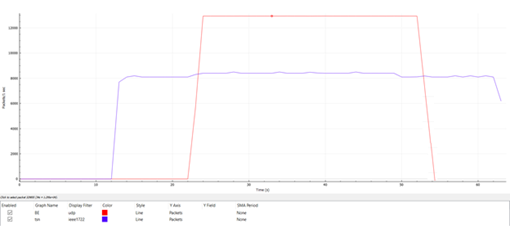
In this scenario, both best-effort traffic (blue line) and
time-sensitive (IEEE 1722 audio frames) traffic (red line) into the same
transmit queue, the traffic transmission of time-sensitive traffic has
unbounded transmission latency and the transmission rate varies greatly
(for example 7900~8100 packets/s). Without CBS or LaunchTime enabled,
the network sees a burst of IEEE 1722 audio frames as driven by the
simple_talker-cmsg application.
Scenario 2: CBS and LaunchTime enabled
This scenario shows CBS and LaunchTime enabled (mqprio
with etf qdisc and per-packet TX time)
Enable CBS with the commands:
tc qdisc replace dev [iface] \
parent root handle 100 mqprio num_tc 3 \
map 2 2 1 0 2 2 2 2 2 2 2 2 2 2 2 2 \
queues 1@0 1@1 2@2 hw 0
tc qdisc replace dev [iface] \
parent 100:1 cbs \
idleslope 7808 \
sendslope -992192 \
hicredit 12 \
locredit -97 \
offload 1Enable LaunchTime with the command:
tc qdisc replace dev [iface] \
parent 200:1 \
etf delta \
clockid CLOCK_TAI \
offload 1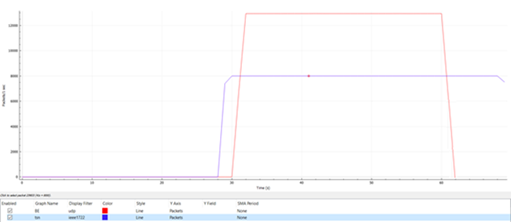
In this case, after enabling CBS and LaunchTime features, different transmit queues are used to separate best-effort and time-sensitive traffic. The CBS capability ensures time-sensitive traffic is bounded to the sawing-effect of credit-based shaping in the case of a heavily loaded transmission path. The LaunchTime capability ensures time-deterministic transmission by setting the per-packet TX descriptor LaunchTime field. As result, the traffic transmission of a SR Class A audio stream has constant transmission latency and the transmission rate is a constant 8000 packets/second, independent of when interfering best-effort traffic enters the system.
Time Aware Shaper (TAS) demo
This demo focuses on the use of 802.1Qbv or Time Aware Shaper (TAS) and the LaunchTime feature of Intel® Ethernet Controller I210 to ensure much more bounded and low latency for period control applications. It includes 3 scenarios:
- TAS and LaunchTime disabled
- TAS enabled
- TAS and LaunchTime enabled
In the demo
ptp4ldaemons run on both the edge gateway and edge device to sync the PTP clock based on 802.1AS Generalized Precision Time Protocol (gPTP), with the edge gateway serving as primary clock and the edge device serving as secondary clock.phc2sysdaemons run on both devices to synchronize the system clock with the PTP clock.- The
sample-app-taprioapplication runs on both devices to transfer scheduled traffic. iperf3runs on both devices to transfer best-effort traffic to stress system communication.- The
tcutility is used to set upmqprio,taprio, andetf(for LaunchTime feature)qdisccapabilities.
Scenario 1: TAS and LaunchTime disabled
This scenario shows TAS and LaunchTime disabled (use
mqprio qdisc only).
Create mqprio with the command:
tc qdisc add dev [iface] parent root mqprio num_tc 4 \
map 3 3 3 0 3 1 3 2 3 3 3 3 3 3 3 3 \
queues 1@0 1@1 1@2 1@3 \
hw 0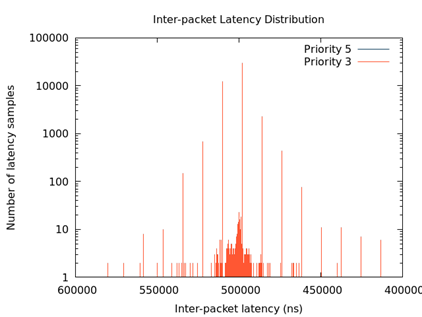
In this case, the distribution of the inter-packet latency for both scheduled traffic (VLAN priority = 5 and 3) has a high sample count at 500 µs, which is the inter-packet cycle time used in this demo. High sample counts observed outside of the chosen inter-packet cycle time indicate poor precision in hitting the expected 500 µs inter-packet cycle time.
Scenario 2: TAS enabled
This scenario shows TAS enabled (use taprio qdisc
only).
Enable TAS with the command:
tc -d qdisc replace dev [iface] parent root handle 100 taprio num_tc 4 \
map 3 3 3 1 3 0 3 2 3 3 3 3 3 3 3 3 \
queues 1@0 1@1 1@2 1@3 \
base-time 1559471513000000000 \
sched-entry S 08 100000 \
sched-entry S 01 100000 \
sched-entry S 02 100000 \
sched-entry S 04 200000 \
sched-entry S 08 100000 \
sched-entry S 01 100000 \
sched-entry S 02 100000 \
sched-entry S 04 200000 \
clockid CLOCK_TAI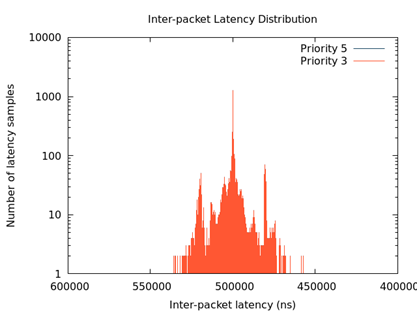
In this case, most of the samples happen at and close to 500 µs. The
sample count quickly drops to a single digit value when it is further
away from the 500 µs inter-packet cycle time. Compared to scenario 1, a
majority of the scheduled traffic is received at close to 500 µs, which
shows that taprio qdisc helps traffic shape the
transmission of scheduled traffic in the time domain.
Scenario 3: TAS and LaunchTime enabled
This scenario shows TAS and LaunchTime enabled (taprio
with etf qdisc and per-packet TX time).
Enable LaunchTime with the command:
tc qdisc replace dev [iface] parent [parent] 1 etf \
clockid CLOCK_TAI \
delta [DELTA_nsec] \
offload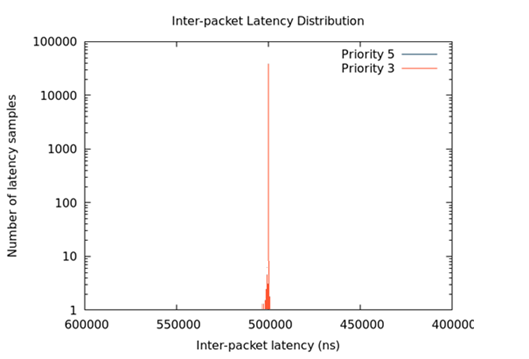
In this case, the inter-packet latency distribution for both
scheduled traffic is greatly reduced compared to previous cases. This
result is consistent with the fact that LaunchTime technology ensures
scheduled traffic is pre-fetched ahead of time from system memory into
the Ethernet MAC controller for transmission at the defined time. The
transmission gating effect of taprio qdisc provides a
protected transmission window for scheduled traffic from interfering
with best-effort traffic. As a result, combining these two technologies
ensures that Ethernet frames for scheduled traffic are sent out in a
protected transmission window at accurate times.